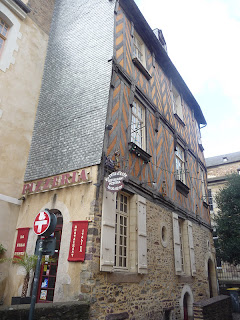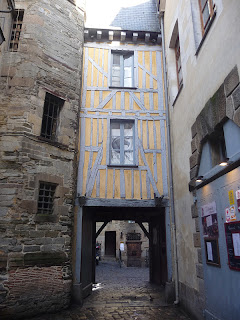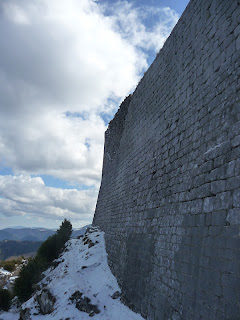The photos were taken during Feb, my first visit to Rennes. We had a wonderful weekend visiting Rennes, having the best crépes till then (that was before our visit to St Malo...), unfortunately the medieval restaurant was fully booked - but we've managed to find a table in a restaurant based in a medieval building and enjoyed an excellent dinner. (Food in France is good, no matter which region you visit!)
Above: our restaurant was through this entry to the left (up in the tower)
Entrance to the restaurant
the canal going through the town (actually the river Vilaine which was canalised after several floods)
the opera
Above: the rooftop of their parliament building, rebuilt according to the original plan after the old building was destroyed by fire in 1994
they have a lively market
The porte mordelaise, one of the four original entries to the town. It was constructed in the 3rd century, although renewed several times, hence the current architecture dates from the 15th century
above: the cathédrale saint-pierre de Rennes, construction commenced in the 16th century, but it was only completed in 1845
Well, what a week - I had to fill up the food cupboards, keep up with the washing and ironing that I won't be exhausted by the time I'm on the aeroplane, clean the house (and there are far more spiderwebs and dust than in SA!) and at the same time finalise all my arrangements to see as many people as possible while spending only 3 days in Gauteng! Without a cellphone, so important to arrange time and place! And to make matters worse, our computer finally greeted us on Friday morning! With all my information and flight tickets on the computer.... So to my relieve I could find print outs of my Air France tickets in a file. For my Jhb-CT flight I fortunately wrote down the ref nr and could phone Voyager and ask them to mail the ticket again, to JL. In a country where very few people believe in God, they looked at me in a strange way when I told them that it was due to my prayers that we could get a technician by this morning to assist us, as one normally has to wait 3-4 days. By lunch time we went to Reims to buy a new computer, one was sold out, but we've managed to find another computer that turned out to have a slightly faster processor and even though it was 50 euros more expensive, we've got 60 euros vouchers (always welcome in a book loving family).
So, I was hoping to finish off on Bretagne before my trip to SA, but I fear the best I'll have to keep until my return. As one need time to share about St Malo and Cancale, as they count under the most beautiful places I've visited in France. So, à bientôt! I'll continue to share on my return mid-Dec!




































































